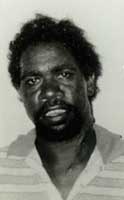
Age: 24 Years when missing Height:
180 cm Hair: Black Eyes: Brown
Richard MILGIN has been missing since
December, 1993. At that time he resided at
Looma Aboriginal Community (near Derby) WA. He
was not reported missing until the 22nd of
February, 1995. Despite extensive inquiries
by Police and family and comprehensive media
coverage, there has been no information
regarding his whereabouts since then.
Concern is held for his welfare.
If anyone has seen Richard MILGIN , or has
information regarding this persons
whereabouts, please contact 1800 333
000
Link to Podcast - https://www.smh.com.au/national/they-were-young-in-love-and-defying-the-most-powerful-men-in-their-community-20180712-p4zr0m.html
Julie Buck was promised to an older man when the young mother defied traditional law and fell in love. Her body was found under a tree, her lover is presumed dead. It’s taken 24 years but people are starting to talk.
By Richard Baker - SMH
The body of Julie Buck, pictured above as a young girl, had been left abandoned in the bush for months when it was found by a group of boys near the remote Aboriginal community of Looma in the Kimberley.
It was two weeks before Christmas 1994 and the boys were out gathering bush tucker when they noticed their dogs sniffing around a scrubby cockleberry tree; they found Julie’s decomposing body, clad in a denim skirt. Hearts pounding, the boys raced back to tell their elders.
After much debate, police from Derby, a 100-kilometre drive west towards the coast, were called to collect the remains.
Dental records confirmed the body as that of the 23-year-old mother who had vanished from Looma 11 months earlier at the height of the wet season – the time of year when the Kimberley floods with tropical rains and, it is said, people disappear.
But it wasn’t just Julie who went missing. Her 24-year-old boyfriend, Looma man Richard Milgin, also vanished. He has not been seen since.
Twenty four years later, there remains no official explanation for what happened to Julie and Richard. Their story has never been told – not a single word written or spoken. No cause of death for Julie has been established and Richard’s bank account, unemployment benefits and health records have not been touched.
The mystery of Julie and Richard is at the centre of Fairfax Media's new investigative podcast, Wrong Skin. The podcast is the result of a year-long investigation examining the possibility that they were victims of “tribal punishment” that got out of hand.
It features family and friends of the young couple who have overcome fears of retribution to speak out in the hope that public exposure might bring some answers and justice.
A mob attack – justified by tribal punishment– has emerged as a major line of inquiry in a fresh investigation by Western Australia’s Cold Case Homicide Squad, with detectives recently submitting a detailed report to the WA Coroner.
Fairfax Media’s investigation has prompted several people to speak to police for the first time. Listeners will be introduced to Indigenous voices rarely heard in mainstream Australia speaking about the treatment of women in remote communities, the magic and spirituality of the Kimberley environment and the harsh realities of life in a part of the country few of us know much about.
The series also turns the spotlight on those who have obtained and maintained power in the Kimberley, raising important questions about who is benefiting from control of potentially lucrative native title processes.
The podcast title Wrong Skin comes from the phrase used in the Kimberley to describe Aboriginal couples in relationships that are forbidden under traditional law.
Richard and Julie were in such a relationship. Not only was Julie the promised wife of a senior Looma man three times her age, she was from a skin group that made her poison to Richard. In the past, those caught in a wrong skin relationship risked harsh physical punishment from senior men who enforced traditional law.
But by 1994, when the couple disappeared, some in the Kimberley believed that the promising out of girls to older men and violent punishment for forbidden relationships was a cultural practice that should be relegated to the past.
When Richard and Julie disappeared, a story was spread that they had eloped to escape the pressure caused by their relationship. However, their family and friends knew that neither of them would leave their young children behind for so long. At the time of her disappearance, Julie had a seven-year-old daughter, Zaria; Richard had a young son, Gino, from a previous relationship.
Julie’s older brother, Graham Bodey, says the last time he saw his sister she looked troubled. “She wasn’t really happy back then, when I saw her,” he says. Graham wants answers about what happened: “I still in my heart believe there’s justice to be done, you know.”
Richard’s brother Wayne lives in Looma. He too is holding out for answers about his brother’s fate and believes there are people in the Kimberley who know more.
“We still got it in our heads, just like yesterday, we still got the memories, what happened and how he was, you know? I can still picture him, how he looks, with a smile,” Wayne recalls.
“Whoever knows about it, any information, or last seen, or what happened. Just come forward. See the police.”